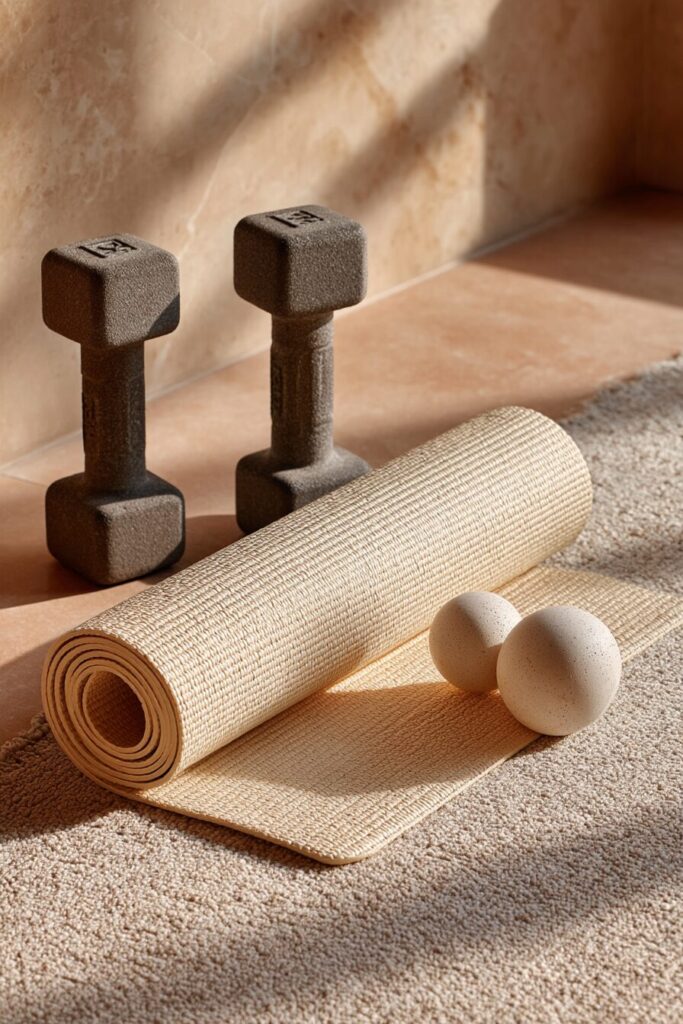Approaching a home workout without a plan is like assembling furniture without instructions—you might end up frustrated and without the results you want.
The challenge lies in creating a routine that keeps you motivated, whether you’re in the gym or exercising at home. Not everyone has access to a personal trainer, and professionally designed programs can come with a hefty price tag.
But building an effective workout routine doesn’t have to be complicated or costly. With a little strategy, you can design a plan that fits your goals and keeps you committed. Here’s how to make it work.
Why Routines Matter
A well-designed workout routine can enhance your training and push you closer to your goals. Your body’s response to exercise depends on factors such as the number of repetitions, the order of movements, rest intervals, time under tension, and the weight you lift—all of which influence your results.
Just as crucial is making sure your routine is enjoyable and supported socially. If you dislike the exercises or feel isolated, you’re less likely to stay committed, making consistency a challenge. The key to long-term success is building a routine that fits your preferences and keeps you engaged.
Creating Your Home Workout Routine
Designing your workout routine starts with understanding your goals, lifestyle, schedule, and preferences. If muscle building is your priority, weight training should be at the core of your plan.
For those focused on cardiovascular endurance, cardio exercises will take center stage. And if weight management is the goal, a balanced mix of cardio and strength training is the way to go. Below, you’ll find guidance on structuring routines for both cardio and strength workouts.

Cardio Workouts
Consistency is the foundation of effective cardio workouts. To make it sustainable, choose an activity that keeps your heart rate elevated and feels enjoyable—whether it’s kicking a punching bag, dancing to high-energy music, or cycling on an exercise bike. If back support is a concern, a recumbent bike might be a better fit.
Next, determine how often you’ll incorporate cardio into your routine. Some people stick to just one session per week, while others aim for three or four. The key is finding a frequency that aligns with your goals and schedule.
When deciding the length of each workout, consider both your availability and fitness level. If you only have 20 minutes, make the most of that time. If your endurance limits you to 10 minutes, start there and gradually build up.
For specific goals like marathon training or improving pace time, balance long-duration, low-intensity sessions with short bursts of high-intensity workouts. This strategy engages different muscle fibers and ensures adequate recovery between sessions.
As your fitness improves, you can gradually increase both intensity and duration through a structured approach known as periodization. Research suggests that running performance significantly improves after a six-week periodized training cycle.
Once you’ve completed the peak phase of your program, taking a two-week recovery period is crucial before starting a new cycle. If your focus is fat loss, applying periodization principles can enhance cardiovascular health and accelerate fat-burning progress.
Periodization techniques can be applied to weight training to steadily increase workload over several weeks by adjusting rep ranges, rest periods, and weights. After your peak week—the final stage of your program—taking two weeks for rest and recovery is essential.
Start by determining how many days you can commit to working out, then structure your body part split accordingly. If you can only train twice a week, a full-body routine or an upper/lower body split may be ideal.
For those with three or more workout days, consider grouping muscle groups that naturally work together, such as chest, triceps, and shoulders; back and biceps; and legs. The key is ensuring the total workout volume—the number of sets and reps—is consistent, whether you train twice or four times a week.
After choosing your split, decide on your rep range and sets per exercise. In the initial phase, aim for three to four sets of 10 to 12 reps. If the final rep feels easy, increase the weight. Maintain this rep scheme for two weeks, then progress to two or three sets of 8 to 10 reps. After another two weeks, shift to 6 to 8 reps per set. If space is a concern, adjustable kettlebells or dumbbells can be a great alternative.
Rest intervals are equally important. Lighter weights and higher reps typically require 30 to 60 seconds of rest. Moderate rep ranges benefit from 60 to 90 seconds, while heavy loads call for 2 to 5 minutes between sets.
Finally, structure your exercises strategically. Begin with compound movements that target large muscle groups—such as squats—before incorporating isolation exercises, like leg extensions. This approach optimizes strength gains and overall progression.

Weight Workouts
Periodization techniques can be applied to weight training to steadily increase workload over several weeks by adjusting rep ranges, rest periods, and weights. After your peak week—the final stage of your program—taking two weeks for rest and recovery is essential.
Start by determining how many days you can commit to working out, then structure your body part split accordingly. If you can only train twice a week, a full-body routine or an upper/lower body split may be ideal.
For those with three or more workout days, consider grouping muscle groups that naturally work together, such as chest, triceps, and shoulders; back and biceps; and legs. The key is ensuring the total workout volume—the number of sets and reps—is consistent, whether you train twice or four times a week.
After choosing your split, decide on your rep range and sets per exercise. In the initial phase, aim for three to four sets of 10 to 12 reps. If the final rep feels easy, increase the weight. Maintain this rep scheme for two weeks, then progress to two or three sets of 8 to 10 reps. After another two weeks, shift to 6 to 8 reps per set. If space is a concern, adjustable kettlebells or dumbbells can be a great alternative.
Rest intervals are equally important. Lighter weights and higher reps typically require 30 to 60 seconds of rest. Moderate rep ranges benefit from 60 to 90 seconds, while heavy loads call for 2 to 5 minutes between sets.
Finally, structure your exercises strategically. Begin with compound movements that target large muscle groups—such as squats—before incorporating isolation exercises, like leg extensions. This approach optimizes strength gains and overall progression.

Sample Weekly Workout Schedule
You may be wondering what your workout routine will look like once you put everything together. Below, we provide you with an example of a weekly cardio routine and a weekly weight routine.
Here’s a structured table based on your cardio workout plan:
| Day | Type | Duration | Activity |
| 1 Low | 30 min | Light Jog or Walk |
| 2 Moderate Intensity | 30 min | Running or Ride |
| 3 Rest | ||
| 4 | ||
| 5 High Intensity | 10 min | HIIT (Jumping Rope) |
| 6 Moderate Intensity | 30 min | Running or Bike Ride |
| 7 Rest |
Weight Workout
This workout prioritizes compound movements before single-joint exercises to maximize energy for larger muscle groups. To reduce the risk of injury and overtraining, begin each exercise with a warm-up set using 40% to 60% of your intended training load for 10 to 12 reps. For example, if your first set involves a 30-pound dumbbell, start with a 12-pound dumbbell for the warm-up. Investing in adjustable dumbbells or a home gym setup can make this process more efficient.
| Day | Type | Duration | Activities |
| 1 Chest/Shoulders/Triceps | 3 Sets x 10-12 Reps (30-60 second rest between sets) | Bench press, inclined dumbbell fly, seated shoulder press, standing dumbbell raises, triceps dips, dumbbell kickback |
| 2 Rest Day | ||
| 3 Back/Biceps | 3 Sets x 10-12 Reps (30-60 second rest between sets) | Lat pulldown, seated cable row, single arm dumbbell row, standing barbell curl, seated preacher curl, single arm hammer curl |
| 4 Rest Day | ||
| 5 Legs | 3 Sets x 10-12 Reps (30-60 second rest between sets) | Squat, lunges, seated leg extension, good mornings, glute bridge, lying hamstring curl |
| 6 Rest Day | ||
| 7 Rest Day |
Helpful Tools & Tips for Sticking to Your Routine
The most effective workout routine is one that keeps you engaged and motivated. Research shows that choosing an activity you genuinely enjoy—and having a support system—significantly increases the likelihood of sticking with it long-term.
A workout partner or community can be a game-changer for consistency. If you don’t have someone to train with, consider joining an online fitness group or subscribing to a home gym program to stay accountable.
Consistency is key to progress, but so is setting realistic expectations. Dressing in workout gear that makes you feel confident—like a well-fitted two-piece set—can help reinforce your commitment. More importantly, be honest about your schedule. If you can realistically train three times a week, set that as your goal instead of aiming for six and falling short. Success builds momentum, so it’s better to hit achievable targets and build from there.
Leveraging modern tools like fitness apps and streaming workouts can also help keep you on track, making it easier to stay committed and reach your fitness goals.
Streaming Apps
These days, there’s an app for everything—including planning your workouts. Whether you prefer standalone fitness apps or programs tailored to specific equipment like rowing machines or treadmills, there are plenty of options to choose from. If you’re looking for something unique Bodi offers on-demand classes for a fresh approach to training.
Many fitness apps provide full workout routines customized to your goals and body type, along with live and pre-recorded classes. Plus, detailed video libraries guide you through various exercises to ensure proper form. Tracking your progress is easier than ever, with built-in features to monitor past workouts and improvements over time.
If accountability is what you need, plenty of apps allow you to connect with friends, join a community, and participate in challenges. Whether you stick with a free version or upgrade to a paid plan, streaming apps can be a powerful tool for staying consistent and motivated in your fitness journey.

Fitness Planners
There’s something special about putting pen to paper and seeing your plan unfold before you. For those who enjoy a hands-on approach to organization, a fitness planner can be the key to maintaining consistency in your routine.
The beauty of a fitness planner lies in its flexibility—you design your plan to fit your unique goals while the planner helps keep everything structured. Many planners include dedicated sections for goal setting, workout tracking, and scheduling. Some even feature calendars, nutrition and hydration logs, cardio workout records, and inspiring affirmations to keep you motivated.
When choosing a fitness planner, consider factors like size, layout, cost, and features that align with your needs. Finding one that suits your style increases the likelihood of regular use. Adding an element of fun—like a thoughtfully chosen planner—can boost engagement and long-term commitment to your fitness journey.

Bottom Line
committed and moving toward your fitness goals. Remember, there’s no universal formula for success. Tailoring your routine to match your lifestyle, experience level, and personal preferences makes it easier to stay consistent and motivated.
Leveraging modern tools like streaming apps and fitness journals can simplify the process and enhance your progress. If you’re unsure about the best approach for your needs, consulting a healthcare professional can provide guidance based on your medical history and fitness level.
